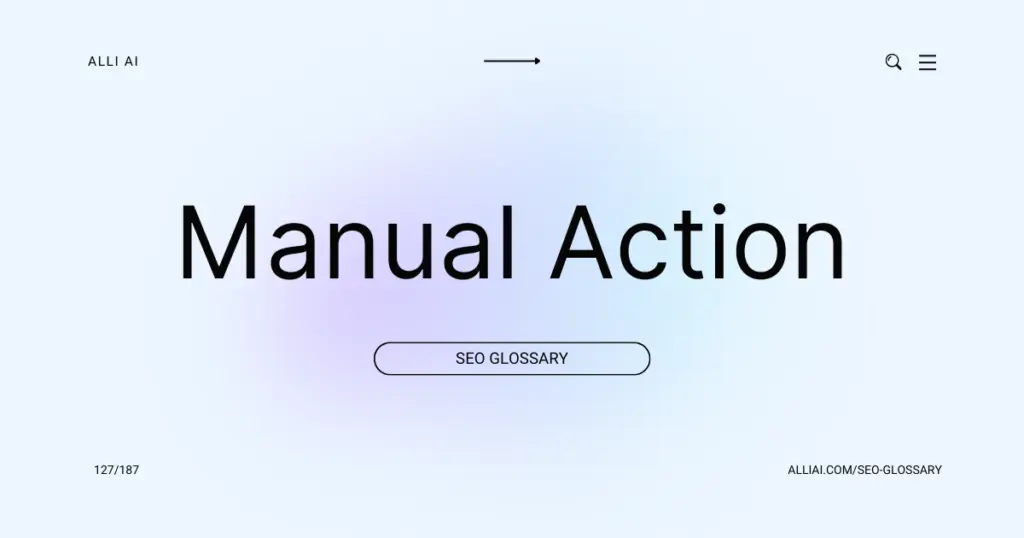What Does Manual Action Mean?
A Manual Action is a penalty imposed by Google on a website when it determines that the site has violated its Webmaster Guidelines. This action is manually applied by Google’s review team after they find that practices such as spammy links, low-quality content, or deceptive behavior have been used to manipulate search rankings. This can result in the website being demoted in search results or even completely removed from Google’s search index. To resolve a Manual Action, a website owner needs to fix the issues and submit a reconsideration request to Google.
Where Does Manual Action Fit Into The Broader SEO Landscape?
Manual actions are penalties imposed by Google on websites that do not comply with the search engine’s Webmaster Guidelines. This typically occurs due to actions deemed as manipulative or deceptive SEO techniques, such as participating in link schemes, cloaking, or creating thin content. Being subjected to a manual action can result in the affected website being demoted in search rankings or completely removed from search results.
In the broader SEO landscape, understanding manual actions is crucial for maintaining or recovering search engine rankings. SEO practitioners must ensure that their strategies adhere to Google’s guidelines to avoid penalties. Additionally, knowing how to address and resolve any manual actions through Google Search Console is essential for restoring a website’s standing in search results. This aspect of SEO is focused on maintaining the integrity and quality of the web and ensuring that practices that provide users with the best possible search results are adhered to.
Real Life Analogies or Metaphors to Explain Manual Action
1. Manual Action is like a red card in soccer: Just as a referee issues a red card to a player for serious rule violations, affecting their ability to play in the game, Google issues a Manual Action to websites that seriously violate its guidelines, affecting their visibility in search results.
2. Manual Action is similar to being pulled over by traffic police: Just as you might be pulled over for not adhering to traffic laws, a website can be flagged by Google for not following its guidelines, leading to a manual review and possible penalties.
3. Manual Action is like a health inspector’s notice: Just as a restaurant might be flagged by a health inspector for not meeting health and safety standards, a website can be flagged by Google for not meeting specific standards and guidelines, requiring corrective action to regain status.
4. Manual Action is akin to a teacher catching a student cheating on an exam: In the same way that a student might face consequences for breaking the rules, a website can receive a Manual Action for trying to manipulate search rankings through unacceptable SEO practices.
How the Manual Action Functions or is Implemented?
1. Detection: Google’s algorithms or human reviewers identify potential guideline violations on a website.
2. Manual Review: If suspicious activity is detected, a human reviewer checks the website to confirm whether it violates Google’s Webmaster Guidelines.
3. Issuing Manual Action: If a violation is confirmed, Google issues a manual action against the site. This action is communicated through the Google Search Console to the site’s webmaster.
4. Types of Manual Actions: These can include penalties such as unnatural links to or from your site, thin content, sneaky redirects, hidden text, and more.
5. Notification: The site owner receives a notification in Google Search Console specifying the type of manual action imposed and the affected pages or links.
6. Effect on Search Rankings: The imposed manual action typically results in a drop in search rankings for the site or the removal of the site from Google’s search results entirely, depending on the severity of the violation.
7. Resolution and Reconsideration Request: The site owner must fix the issues highlighted in the manual action notification. Once these changes are made, the owner can submit a reconsideration request through Google Search Console.
8. Review of Reconsideration Request: Google reviews the changes made by the site owner to ensure compliance with their guidelines. This process can take several weeks.
9. Lifting of Manual Action: If the reviewer is satisfied that the website complies with Google’s guidelines, the manual action is revoked, and the site’s rankings can begin to recover.
Impact Manual Action has on SEO
A Manual Action from Google significantly impacts a website’s SEO performance and rankings, typically resulting in a severe drop in search visibility. This action is taken by Google’s human reviewers when they determine that pages on the site do not comply with Google’s webmaster quality guidelines. Common reasons include spammy content, hidden text, unnatural links, cloaking, and pure spam tactics. The effect can be site-wide or specific to certain pages.
As a consequence of Manual Action, a website might be demoted in search rankings or completely removed from Google search results, leading to a substantial decrease in organic traffic. This decline in traffic adversely affects the user experience by reducing the credibility and trustworthiness perceived by users. Additionally, resolving these actions typically requires significant changes to the website and a formal review request to Google, during which time the negative impacts persist.
SEO Best Practices For Manual Action
1. Identify the specific type of manual action from Google Search Console.
2. Analyze your website to pinpoint the issues that have led to the manual action.
3. Remove or update the violating content as per Google’s guidelines.
4. Disavow bad backlinks using the Google Disavow Tool if needed.
5. Submit a reconsideration request through Google Search Console once all corrections are made.
6. Monitor your email and Google Search Console for any response from Google about the status of your request.
Common Mistakes To Avoid
1. Buying Links or Participating in Link Schemes: This violates Google’s guidelines. To avoid this, focus on earning links naturally by producing high-quality content and engaging with your community.
2. Using Automatically Generated Content: Such content typically offers little value to users and can lead to penalties. Create meaningful, well-researched content instead.
3. Cloaking and Sneaky Redirects: Showing different content to users versus Googlebot leads to a poor user experience and is misleading. Ensure that all users and bots see the same content.
4. Hidden Text and Links: These are used to manipulate Google’s algorithms by hiding additional keywords. Make sure all your text is visible to users and use legitimate design practices.
5. Doorway Pages: Created solely for drawing search engine traffic, they can disrupt a user’s experience. Focus on improving user engagement and providing value directly through your main site.
6. Scraped Content: Using content from other sites without adding significant value can attract penalties. Instead, invest in original content or enhance scraped content with your unique analysis, commentary, or reporting.
7. Abusing Rich Snippets Markup: Misusing structured data to deceive search engines can lead to a manual action. Use markup honestly to represent your page content properly.
8. User-Generated Spam: Unmoderated comments or forum posts can lead to issues. Implement measures to monitor and moderate user content, such as CAPTCHAs, and user verification.
9. Malware and Harmful Behavior: Hosting malware or redirecting users to harmful sites can lead to severe penalties. Regularly scan your website for malware and ensure all security patches are up-to-date.
10. Affiliate Programs Without Added Value: Simply hosting affiliate links without any unique content can be seen as spammy. Add substantial value to any affiliated content you post to differentiate yourself from other affiliates.
Regularly check Google Search Console for notifications or warnings about these issues and address any detected problems promptly to avoid further penalties.






